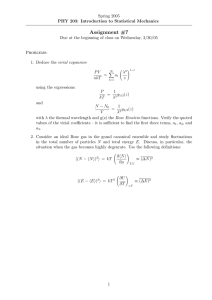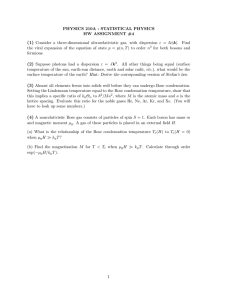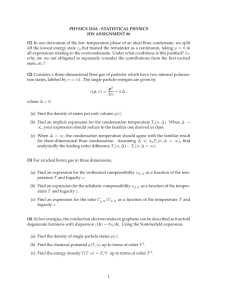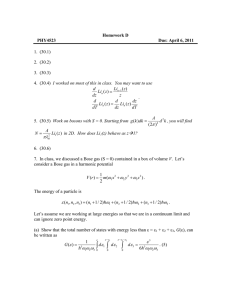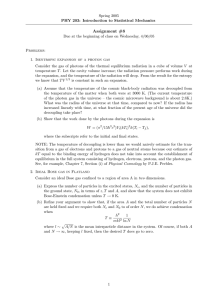Monte Carlo study of Bose Laughlin wave function for filling factors /
advertisement
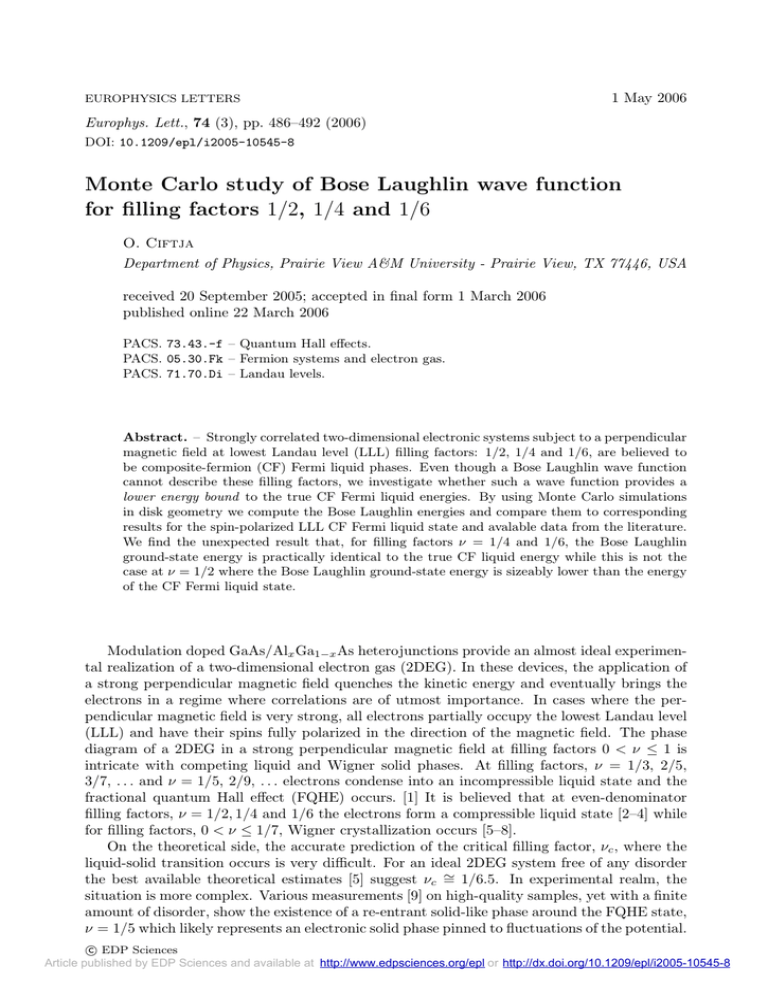
EUROPHYSICS LETTERS
1 May 2006
Europhys. Lett., 74 (3), pp. 486–492 (2006)
DOI: 10.1209/epl/i2005-10545-8
Monte Carlo study of Bose Laughlin wave function
for filling factors 1/2, 1/4 and 1/6
O. Ciftja
Department of Physics, Prairie View A&M University - Prairie View, TX 77446, USA
received 20 September 2005; accepted in final form 1 March 2006
published online 22 March 2006
PACS. 73.43.-f – Quantum Hall effects.
PACS. 05.30.Fk – Fermion systems and electron gas.
PACS. 71.70.Di – Landau levels.
Abstract. – Strongly correlated two-dimensional electronic systems subject to a perpendicular
magnetic field at lowest Landau level (LLL) filling factors: 1/2, 1/4 and 1/6, are believed to
be composite-fermion (CF) Fermi liquid phases. Even though a Bose Laughlin wave function
cannot describe these filling factors, we investigate whether such a wave function provides a
lower energy bound to the true CF Fermi liquid energies. By using Monte Carlo simulations
in disk geometry we compute the Bose Laughlin energies and compare them to corresponding
results for the spin-polarized LLL CF Fermi liquid state and avalable data from the literature.
We find the unexpected result that, for filling factors ν = 1/4 and 1/6, the Bose Laughlin
ground-state energy is practically identical to the true CF liquid energy while this is not the
case at ν = 1/2 where the Bose Laughlin ground-state energy is sizeably lower than the energy
of the CF Fermi liquid state.
Modulation doped GaAs/Alx Ga1−x As heterojunctions provide an almost ideal experimental realization of a two-dimensional electron gas (2DEG). In these devices, the application of
a strong perpendicular magnetic field quenches the kinetic energy and eventually brings the
electrons in a regime where correlations are of utmost importance. In cases where the perpendicular magnetic field is very strong, all electrons partially occupy the lowest Landau level
(LLL) and have their spins fully polarized in the direction of the magnetic field. The phase
diagram of a 2DEG in a strong perpendicular magnetic field at filling factors 0 < ν ≤ 1 is
intricate with competing liquid and Wigner solid phases. At filling factors, ν = 1/3, 2/5,
3/7, . . . and ν = 1/5, 2/9, . . . electrons condense into an incompressible liquid state and the
fractional quantum Hall effect (FQHE) occurs. [1] It is believed that at even-denominator
filling factors, ν = 1/2, 1/4 and 1/6 the electrons form a compressible liquid state [2–4] while
for filling factors, 0 < ν ≤ 1/7, Wigner crystallization occurs [5–8].
On the theoretical side, the accurate prediction of the critical filling factor, νc , where the
liquid-solid transition occurs is very difficult. For an ideal 2DEG system free of any disorder
the best available theoretical estimates [5] suggest νc ∼
= 1/6.5. In experimental realm, the
situation is more complex. Various measurements [9] on high-quality samples, yet with a finite
amount of disorder, show the existence of a re-entrant solid-like phase around the FQHE state,
ν = 1/5 which likely represents an electronic solid phase pinned to fluctuations of the potential.
c EDP Sciences
Article published by EDP Sciences and available at http://www.edpsciences.org/epl or http://dx.doi.org/10.1209/epl/i2005-10545-8
O. Ciftja: Monte Carlo study of Bose Laughlin wave function etc.
487
The majority of theoretical studies which are based on models free of any disorder agree that
the critical filling factor, νc below which the Wigner crystal forms is close to and probably
slightly larger than filling factor ν = 1/7 in excellent agreement with the estimate of Lam
and Girvin [5]. A recent study [10] based on the exact diagonalization method found strong
evidence that the Wigner crystal forms at filling factors, ν ≤ 1/7. Such study considered the
filling factors, ν = 1/6, 1/7, and 1/8. It was found that for ν = 1/8, as well as ν = 1/7 the
translational symmetry (signature of liquid phase) is broken and the system has 2D crystalline
order. However, the system continued to have its translational symmetry for the case of filling
factor ν = 1/6, suggesting that the value of the critical filling factor, νc is between slightly
above 1/7, but below 1/6.
The principal FQHE states at ν = 1/3 and 1/5 are thoroughly explained and very well
described by the Laughin wave function [11] while the other FQHE states at filling factors,
ν = p/(2mp + 1) (p, m integer) are readily understood in terms of the composite fermion
(CF) theory. [12] The limit (p → ∞) of such FQHE states [13, 14] corresponds to evendenominator filled states, ν = 1/(2m) which are believed to be compressible Fermi liquid
states qualitatively different from the FQHE states of the originating sequence [15]. The basic
understanding now is that the low-temperature phase of fully spin-polarized electrons at filling
fraction ν = 1/(2m) is a CF Fermi liquid phase. A trial wave function for the CF Fermi liquid
ground state at ν = 1/(2m) has been written down by Rezayi and Read [16] and reads:
(1)
ΨF ermi = P̂LLL det|eikα ri | ΨBose ,
where ΨBose is the Bose Laughlin wave function for filling factor ν = 1/(2m):
N
N
2
|z
|
j
.
(zi − zj )2m exp −
ΨBose =
2
4l
0
i<j
j=1
(2)
The Rezayi-Read (RR) CF Fermi wave function is obtained after the product of the Bose
Laughlin wave function with a Slater determinant of plane waves is fully projected into the
LLL by means of the projection operator, P̂LLL . In the above expressions, N is the number
of electrons that occupy the N lowest-lying single-particle plane-wave states labeled by the
momenta {kα } consistent with an ideal 2D spin-polarized Fermi gas,
zj = xj + iyj is the
position coordinate for the j-th electron in complex notation, l0 = h̄/(eB) is the magnetic
length, B is the perpendicular magnetic field and −e(e > 0) is the electron’s charge.
A straightforward motivation to study the Bose Laughlin wave function in relation to the
true CF liquid state is justified on the naive expectation that, because of the Bose statistics,
the Bose Laughlin energy may constitute a reasonable lower energy bound to the CF Fermi
liquid energies for the given even-denominator filling factors. While this is an expectation
that we cannot prove exactly, an a posteriori justification may be provided if the numerical
results are consistent with it (although we caution that this is not a definitive proof in any
way). The assumption that corresponding Bose Laughlin and CF liquid ground-state energies
should be reasonably different from each other (given the very different nature of the wave
functions) is more relevant to us in contrast to the question of whether the Bose Laughlin
wave function is an exact lower energy bound of the true CF liquid energy.
The main result of this work is not to assert the relevance of the Bose Laughlin wave
function at filling factors 1/2, 1/4, and 1/6, but to report a surprising and unexpected finding,
namely that the energy of the Bose Laughlin wave function at ν = 1/4 and 1/6 (but not 1/2)
is practically identical to the energy of the corresponding true CF Fermi liquid state.
488
EUROPHYSICS LETTERS
The model that we adopt consists of N fully spin-polarized electrons moving in a twodimensional (2D) space subject to a strong perpendicular magnetic field. The electrons are
embedded in a uniform neutralizing background of positive charge which is spread uniformly
2
and radius RN . The electrons can move freely all
within a finite disk of area ΩN = π RN
over the 2D space and are not constrained to stay inside the disk. The uniform density of the
the disk is determined from the condition: ρ0 = N/ΩN
system is ρ0 = ν/(2πl02 ). The radius of which gives a finite disk radius RN = l0 2N/ν. The kinetic energy per electron corresponding
to the Bose Laughlin wave function is K̂
/N = h̄ ωc /2, where ωc is the cyclotron frequency.
Since the kinetic energy per electron is a mere constant, the problem reduces to calculate the
expectation value of the potential energy operator which consists of three terms:
V̂ = V̂ee + V̂eb + V̂bb ,
(3)
where V̂ee , V̂eb and V̂bb are, respectively, the electron-electron, electron-background and
background-background potential energy operators. For a pure Coulomb interaction they
are given by
V̂ee =
N
i<j
N e2
e2
e2
ρ20
2
2
, V̂eb = −ρ0
, V̂bb =
.
d r
d r
d2 r
|ri − rj |
|ri − r|
2 ΩN
|r − r |
ΩN
i=1 ΩN
(4)
Monte Carlo (MC) simulations in disk geometry [17, 18] are used to calculate the expectation value of the electron-electron and electron-background interaction potentials, V̂ee /N
and V̂eb /N , respectively. The background-background interaction energy can be calculated
exactly and is
νN e2
8
V̂bb =
.
(5)
N
3π
2 l0
In our MC simulations we adopt the well-known Metropolis algorithm [19]. In this algorithm, the expectation value of any operator is estimated by averaging its value over numerous
electronic configurations of {r1 , . . . , rN } coordinates. Our runs consist of 100000 “equilibration” MC steps (a step consists of attempts to move all the electrons one by one) and up to
2×106 “averaging” MC steps used to calculate the expectation value of chosen operators. The
simulations are done for systems of N = 4, 16, 36, 64, 100, 144, 196, 256, 324 and 400 electrons. The correlation energy per particle in the thermodynamic limit (N → ∞) is obtained
by fitting the finite-N energies, V̂ /N to a second-order polynomial function as described in
ref. [17]. The resulting polynomial fits are
V̂ 1/2
N
V̂ 1/4
N
V̂ 1/6
N
0.0280(07) e2
√
= −0.4841(5) + 0.1017(68)
−
N
l0 ,
N
0.0306(964)
0.0184(964) e2
√
= −0.3614(03) +
−
,
N
N
2l0
e
√
= −0.3013(31) + 0.0133(206)
− 0.0151(46)
N
l0 .
N
(6)
The finite-N correlation energies per particle for the Bose Laughlin state at ν = 1/2, 1/4
and 1/6 and their thermodynamic limit values
are displayed in table I. We estimated that the
√
statistical uncertainty (which scales as 1/ MC steps) of the energy data reported in table I is
in the fifth digit after the decimal point which is rounded. Similarly, the statistical uncertainty
of the extrapolated values is in the fifth digit after the decimal
point. We also computed the
N
δ(
r
−
r
)
and
the
pair distribution function
single-particle density function, ρ(r ) =
i
i=1
O. Ciftja: Monte Carlo study of Bose Laughlin wave function etc.
489
Table I – Correlation energy per particle for the Bose Laughlin state at filling factors ν = 1/2, 1/4
and 1/6. Results obtained from a standard Monte Carlo simulation in disk geometry. Energies are in
units of e2 /l0 . The statistical uncertainty in the last digit of energy is shown in paranthesis.
N
4
16
36
64
100
144
196
256
324
400
∞
1/2
−0.4402(8)
−0.4603(8)
−0.4679(7)
−0.4719(2)
−0.4743(2)
−0.4759(2)
−0.4770(5)
−0.4779(0)
−0.4785(3)
−0.4790(4)
−0.4841(5)
1/4
−0.3506(9)
−0.3548(1)
−0.3568(2)
−0.3579(0)
−0.3585(7)
−0.3590(2)
−0.3593(2)
−0.3595(5)
−0.3597(2)
−0.3598(4)
−0.3614(03)
1/6
−0.2984(7)
−0.2988(6)
−0.2995(6)
−0.2999(6)
−0.3002(1)
−0.3003(6)
−0.3004(7)
−0.3005(5)
−0.3006(0)
−0.3006(3)
−0.3013(31)
N N
which for a liquid with uniform density ρ0 is ρ0 g(r) = N1
ri − rj |) . The
i=1
j=i δ(r − |
single-particle density of the Bose Laughlin state shows the expected non-uniformity near the
disk boundary (see fig. 1). Note that the non-uniformity near the disk edge always persists and
increases as the filling factor decreases. The pair distribution function for ν = 1/2, 1/4 and
1/6 obtained after a MC simulation in disk geometry for N = 400 electrons is shown in fig. 2.
We compare the Bose Laughlin energies in the thermodynamic limit as displayed in
the last row of table I to respective values of the LLL-projected spin-polarized CF Fermi
liquid state energies (eq. (1)) at same filling factors. A search in the literature provides
us with the following values for the CF Fermi liquid energy at ν = 1/2: −0.466 e2 /l0
from ref. [20] and −0.46557(6) e2 /l0 from ref. [21]. Both of these values are higher than
the value −0.4841(50) e2 /l0 which corresponds to ΨBose . Reference [20] gives the energy
−0.3608 e2 /l0 for the ν = 1/4 state, a value that is higher than but very close to the energy,
−0.3614(03) e2 /l0 , corresponding to the ΨBose state. We were unable to find data for the
energy of the ΨF ermi state at ν = 1/6. While there are more data for the unprojected version
2
1/2
1/4
1/6
ρ/ρ0
1.5
1
0.5
0
0
20
40
60
r/lo
80
100
120
Fig. 1 – One-body density function, ρ(r)/ρ0 , for the Bose Laughlin states ν = 1/2, 1/4 and 1/6 as a
function of the distance r/l0 from the center of the disk for systems with N = 400 electrons.
490
EUROPHYSICS LETTERS
1.6
1/2
1/4
1/6
1.4
1.2
g(r)
1
0.8
0.6
0.4
0.2
0
0
5
10
15
20
r/lo
Fig. 2 – Pair distribution function of the Bose Laughlin state at filling factor ν = 1/2, 1/4 and 1/6
obtained after a MC simulation in disk geometry for N = 400 electrons.
of the CF Fermi liquid wave function obtained with different methods [22–25], we found only
few results for the fully LLL projected CF Fermi liquid states at the filling factors considered
in this work. In order to have a larger pool of results to whom to compare the ν = 1/2, 1/4
and 1/6 energies, we pursue a different path and resort to interpolation formulas that give the
energy per particle, E(ν) of the electronic liquid state as a function of the LLL filling factor:
0 < ν ≤ 1. A crude empirical formula of this form has been suggested by Laughlin (L) [11]
and reads:
e2
√ .
(7)
EL (ν) = 0.814 ν 0.230 ν 0.64 − 1
l0
Another formula proposed by Levesque, Weis, and MacDonald (LWM) [26] has the form:
ELW M (ν) = −0.782133
e2
√ ν 1 − 0.211 ν 0.74 + 0.012 ν 1.7
.
l0
(8)
Both expressions, EL (ν) and ELW M (ν) are derived by fitting the energy of Laughlin wave
functions and violate the particle-hole symmetry condition in the LLL.
A third interpolation formula which satisfies the particle-hole symmetry condition in the
LLL and therefore provides a more accurate interpolation for the dependence of energy on the
LLL filling factor is given by Fano and Ortolani (FO) [27] and has the form
2
√
e
π
ν − 0.782133 ν (1 − ν)3/2 + 0.55 ν (1 − ν)2 − 0.463 ν 3/2 (1 − ν)5/2
.
EF O (ν) = −
8
l0
(9)
We use the EL (ν), ELW M (ν) and EF O (ν) interpolation formulas to generate more data
for the energies at ν = 1/2, 1/4 and 1/6 and compare the interpolated values to Bose Laughlin
energies at same filling factors. Such energies (in units of e2 /l0 ) are given in table II.
The results in table II and the ν = 1/2 results from refs. [20, 21] suggest that the EL (ν)
and ELW M (ν) formulas are too crude to describe the energy of the electronic liquid states
for the whole range of LLL filling factors. Clearly the Bose Laughlin energy at ν = 1/2
is distinctly smaller than the CF Fermi liquid energy of refs. [20, 21] and FO interpolation
energy, as well. The FO value at ν = 1/2 is close to the spin-polarized CF liquid-state
value [21], although we notice that it is closer to the energy of the spin-unpolarized (singlet)
O. Ciftja: Monte Carlo study of Bose Laughlin wave function etc.
491
Table II – Energy per particle for the LLL states ν = 1/2, 1/4 and 1/6 obtained from interpolation
formulas eq. (7), eq. (8) and eq. (9) as compared with Bose Laughlin state energies. Energies are in
units of e2 /l0 . The statistical uncertainty in the last digits of energy is shown in paranthesis.
E(ν)
EL
ELW M
EF O
Ref. [20]
Ref. [21]
EBose
1/2
−0.490632
−0.485225
−0.469049
−0.46600
−0.46557(6)
−0.4841(50)
1/4
−0.368452
−0.361930
−0.361519
−0.36080
...
−0.3614(03)
1/6
−0.308033
−0.301595
−0.303660
...
...
−0.3013(31)
CF state, −0.46953(7) e2 /l0 reported in ref. [21]. This is not the case for the other two filling
factors, ν = 1/4 and ν = 1/6, where all the interpolation energies including the FO values are
slightly lower than the Bose Laughlin energies, though very close to them. The more accurate
polarized CF Fermi liquid state energy [20] (−0.3608 e2 /l0 at ν = 1/4) is larger than the Bose
Laughlin energy, though it is important to note that the two values are so close that they can
be considered practically identical.
The fact that interpolation energies are slightly lower than the Bose Laughlin energies
at ν = 1/4 and 1/6 surely does not invalidate the possibility of the Bose Laughlin wave
function being a lower energy bound to the true CF Fermi liquid energy since it is well
known [28] that the true energy at any filling factor (excluding the Laughlin filling factors)
is always higher than the approximate energy obtained from L, LWM and FO interpolation
formulas that are smooth functions of ν and should be handled with care. For electronic
LLL Laughlin wave functions (Fermi or Bose) and a bare Coulomb potential, the Haldane
pseudopotential parameters, Vm , are known to be all positive and decrease monotonically as
the relative angular momentum, m, increases. In contrast to the electronic case, the Haldane
pseudopotential parameters (for both bare and screened Coulomb potentials) corresponding
to the CF Fermi liquid states in eq. (1) show a distinct non-monotonic behavior with some
of them even becoming negative for large values of relative angular momentum [29]. In the
CF language, a state with filling factor, ν = p/(2mp + 1) represents a CF system with p-filled
CF LL-s which weakly interact with each other by some residual interaction. In such a case,
the CF Haldane pseudopotentials (both small p and large p) show a qualitatively different
behavior from the electronic LLL Laughlin pseudopotentials. Such a qualitatively different
behavior is likely associated with the weakly interacting nature of the CFs as compared to
pure electrons [30]. Because of the different nature of the two liquid wave functions (eq. (1)
and eq. (2)) and their respective Haldane pseudopotentials, it was unexpected to find that the
Bose Laughlin and the true CF Fermi liquid energies are practically identical for filling factor
ν = 1/4 and 1/6, while clearly distinct for ν = 1/2.
In summary, we used MC simulations to calculate the ground-state properties of Bose
Laughlin wave functions at compressible filling fractions ν = 1/2, 1/4 and 1/6. The calculated
ground-state energies are compared with results for spin-polarized CF wave functions for these
filling factors. We found that the Bose Laughlin wave function ground-state energy is lower
than the CF Fermi liquid energy for ν = 1/2, whereas for other filling factors, ν = 1/4 and
1/6, we find the surprising result that the Bose Laughlin ground-state energy is practically
identical to the energy of the true CF liquid state as calculated from different studies and
from estimates obtained from various interpolation schemes. Because Bose Laughlin and true
CF liquid energies are very different at ν = 1/2, we naively expected to see a similar tendency
apply to the other two even-denominator-filled CF liquid states, ν = 1/4 and 1/6; however,
492
EUROPHYSICS LETTERS
unexpectedly we found out that the Bose Laughlin and true CF liquid energies are practically
identical at filling factors 1/4 and 1/6. The physical significance and robustness of this finding
is not yet clear to us and further work is needed to address this issue.
∗∗∗
This research was supported by the US DOE (Grant No. DE-FG52-05NA27036) and by the
Office of the Vice-President for Research and Development of Prairie View A&M University
through a 2003-2004 Research Enhancement Program grant.
REFERENCES
[1] Tsui D. C., Stormer H. L. and Gossard A. C., Phys. Rev. Lett., 48 (1982) 1559.
[2] Willett R. L., Paalanen M. A., Ruel R. R., West K. W., Pfeiffer L. N. and Bishop
D. J., Phys. Rev. Lett., 65 (1990) 112.
[3] Willett R. L., Ruel R. R., Paalanen M. A., West K. W. and Pfeiffer L. N., Phys.
Rev. B, 47 (1993) 7344.
[4] Willett R. L., Ruel R. R., West K. W. and Pfeiffer L. N., Phys. Rev. Lett., 71 (1993)
3846.
[5] Lam P. K. and Girvin S. M., Phys. Rev. B, 30 (1984) R473.
[6] Esfarjani K. and Chui S. T., Phys. Rev. B, 42 (1990) 10758.
[7] Zhu X. and Louie S. G., Phys. Rev. Lett., 70 (1993) 335.
[8] Zhu X. and Louie S. G., Phys. Rev. B, 52 (1995) 5863.
[9] Jiang H. W., Willett R. L., Stormer H. L., Tsui D. C., Pfeiffer L. N. and West
K. W., Phys. Rev. Lett., 65 (1990) 633.
[10] Yang K., Haldane F. D. M. and Rezayi E. H., Phys. Rev. B, 64 (2001) 081301(R).
[11] Laughlin R. B., Phys. Rev. Lett., 50 (1983) 1395.
[12] Jain J. K., Phys. Rev. Lett., 63 (1989) 199.
[13] Kamilla R. K., Jain J. K. and Girvin S. M., Phys. Rev. B, 56 (1997) 12411.
[14] Ciftja O., Eur. Phys. J. B, 13 (2000) 671.
[15] Halperin B. I., Lee P. A. and Read N., Phys. Rev. B, 47 (1993) 7312.
[16] Rezayi E. and Read N., Phys. Rev. Lett., 72 (1994) 900.
[17] Morf R. and Halperin B. I., Phys. Rev. B, 33 (1986) 2221.
[18] Ciftja O. and Wexler C., Phys. Rev. B, 67 (2003) 075304.
[19] Metropolis N., Rosenbluth A. W., Rosenbluth M. N., Teller A. M. and Teller E.,
J. Chem. Phys., 21 (1953) 1087.
[20] Morf R. and d’Ambrumenil N., Phys. Rev. Lett., 74 (1995) 5116.
[21] Park K., Melik-Alaverdian V., Bonesteel N. E. and Jain J. K., Phys. Rev. B, 58 (1998)
R10167.
[22] Chakraborty T., Phys. Rev. B, 57 (1998) 8812.
[23] Ciftja O. and Fantoni S., Phys. Rev. B, 58 (1998) 7898.
[24] Ciftja O., Phys. Rev. B, 59 (1999) 10194.
[25] Ciftja O., Physica E, 9 (2001) 226.
[26] Levesque D., Weis J. J. and MacDonald A. H., Phys. Rev. B, 30 (1984) R1056.
[27] Fano G. and Ortolani F., Phys. Rev. B, 37 (1988) 8179.
[28] Halperin B. I., Phys. Rev. Lett., 52 (1984) 1583; 2390(E).
[29] Goerbig M. O., Lederer P. and Smith C. M., Phys. Rev. B, 69 (2004) 155324; 70 (2004)
249903(E).
[30] Wojs A. and Quinn J. J., Phys. Rev. B, 61 (2000) 2846.
